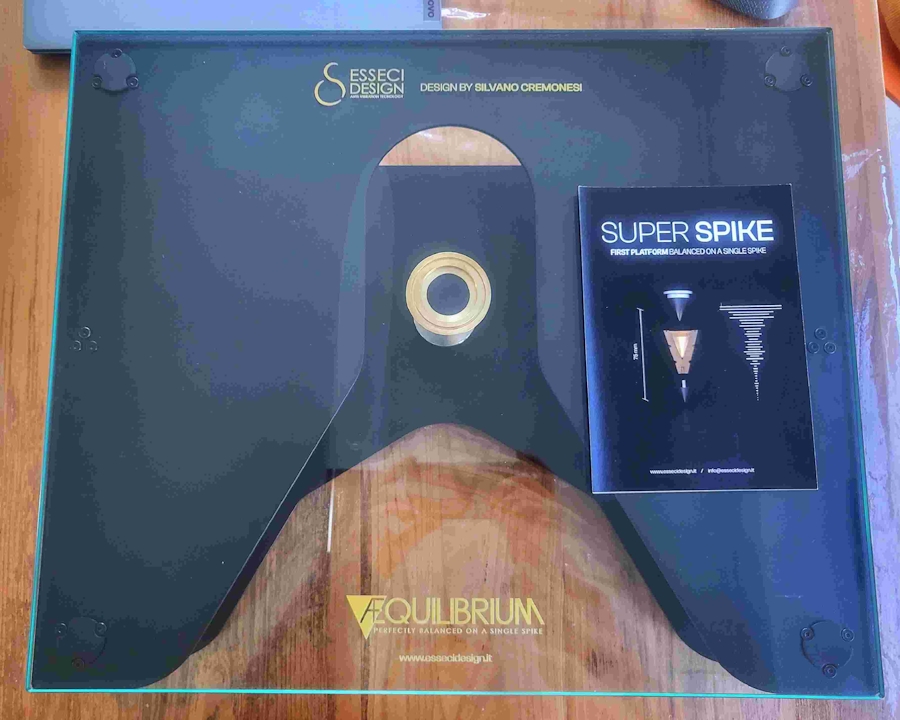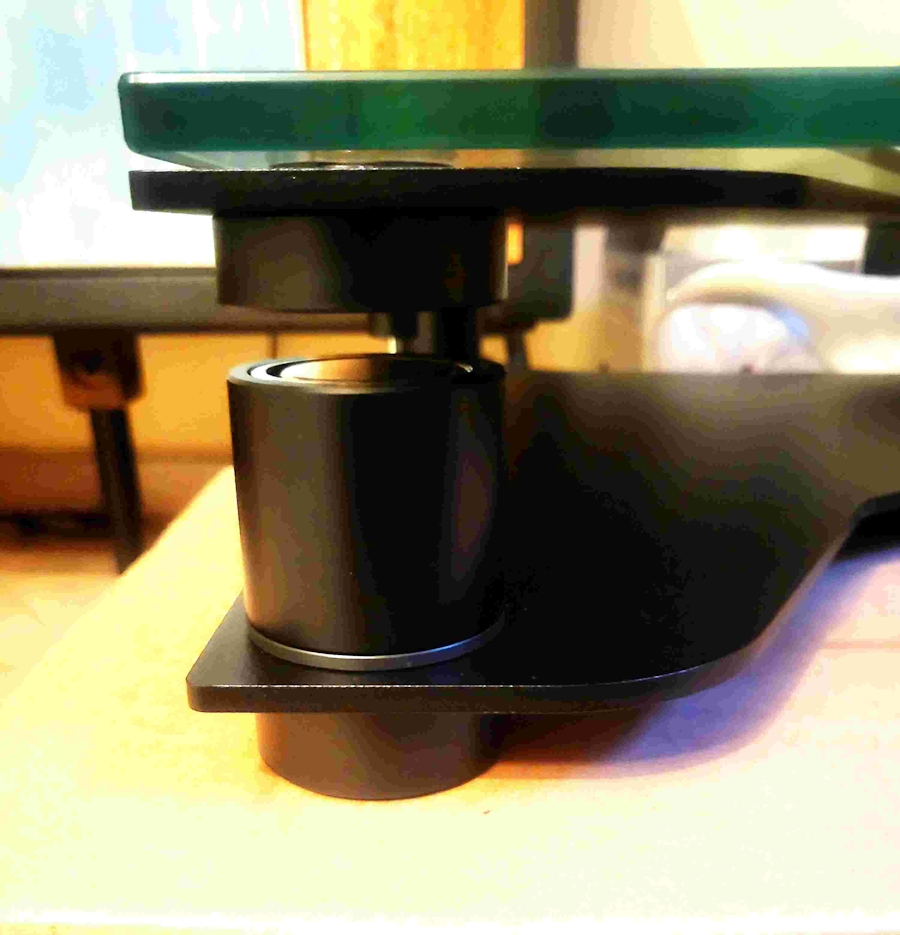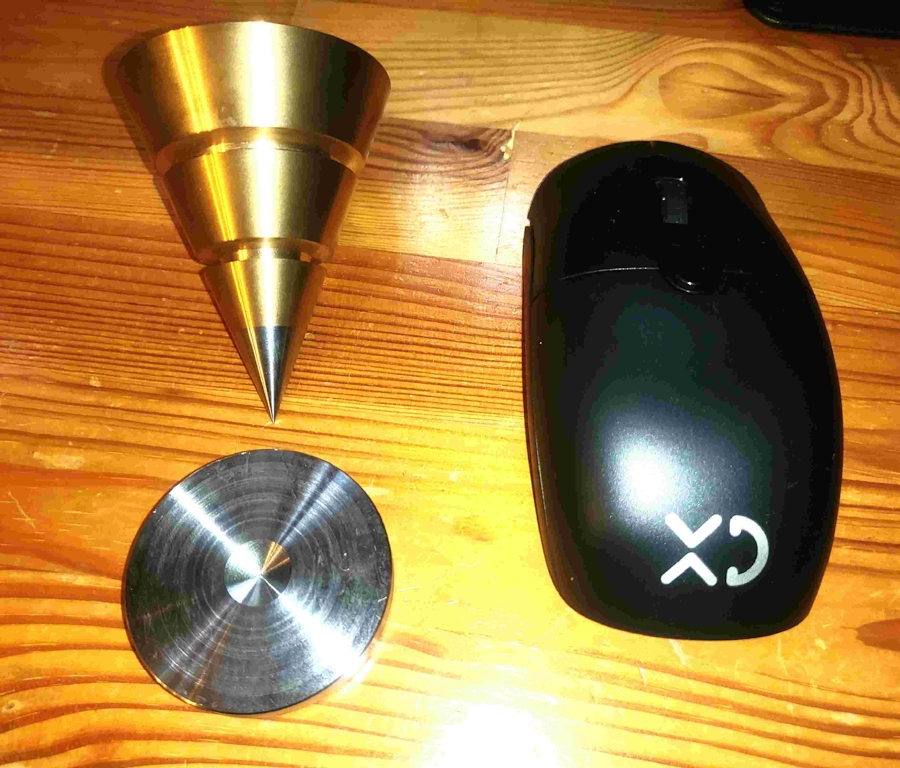Esseci Relaxa Aequilibrium
A true technical tour de force

[ Home TNT-Audio | Staff & Contacts | HiFi Playground | Listening tests | DIY & Tweakings | Music & Books ]

Product: isolation platform for electronics and speakers
Manufacturer: Esseci
Design - Italy
Recommended Retail Price: ± 3600€
Reviewer: Piero Canova - TNT-Audio Italy
Reviewed: February, 2025
I had already tested the
Relaxa 750 magnetic levitation platform in January 2022, obtaining very
positive results, and I thought that this technology had reached the
limit that
could be achieved, but as usual I was wrong. At Esseci, they have posed
the problem
of how to take the concept of the spike as a support base to the extreme.
Without
going into too much detail, when we decide to replace the standard feet
under
our devices, we use two different approaches: insulating and damping
materials
or rigid couplings that connect the device to the support surface
below. Among
the latter, the most common solution is the spike. I believe there have
been
treaties written on spikes and you can find them in various shapes and
very
different materials. They have their own sound imprint in the sense
that,
generally, the use of spikes is associated with a drying effect on the
bass and a
general effect of cleaning the sound. Normally, three or four of them are used
under the
device that you want to treat, in most cases combined with tailstocks
to avoid
damaging the support surface.
Esseci asked themselves the question of whether it was possible to
build a base
that rests on a single spike and that has a maximum capacity of 100 kg.
As you
can understand, designing a spike that can support 100 kg without
deforming, that
can stay balanced and that can play well is not a trivial exercise, but
in the
end they succeeded and presented it at various fairs, obtaining first
prize at
the AA Award Grand Prix in Japan last December, so we are faced with a
product
that has already received important approval. From a construction point
of
view, it consists of two metal frames of significant mass that are kept
apart
by four magnets placed at the corners; a very thick glass surface rests
on the
upper frame on which our component rests. In the image below you can
see the
detail of one of the corners.

The lower magnets can be adjusted in height to level the platform. The upper frame has a deep slot in the center where the spike that will support the entire load is inserted. It is a spike of significant size and mass made of three different materials: stainless steel below, brass in the center and aluminum to fill the brass. In the photo below you will see the spike, the tailstock and a mouse to help you appreciate the size of these two pieces.

The spike and tailstock are not in a fixed position. Since the component usually weighs more on one side because it contains the power supply and transformer, you will have to move the tip in the direction in which the plane slopes. Also, the small play that allows you to insert the spike disappears and all the mass is supported by it. The question at this point is how it behaves and what effects it has on the sound of our components.
The first thing I was advised to do was to put a device with a certain mass on it. I was expecting a super spike sound and instead the result is very different. Let me explain: that drying effect at the lower frequencies tending to arid that I have found in many tests is not there and this intrigued me a lot. I asked for clarification and the answer was that, above a certain load, the spike is built to behave like a spring; it may seem strange but elastic elements in solid metal are normally used in the automotive industry and are called torsion bars. In this case, the construction provides that one metal of the spike acts as an elastic element while another probably plays the role of vibration damper. The result is a sound that is halfway between that of an elastic element and a spike. It could be close to that of a very well damped spring suspension but without that tendency to thicken the sound that springs often have. I could sum it all up by saying that it adds up the positive aspects of both solutions while cancelling the negative ones. I tested it by placing it under turntables, CD mechanics and amplifiers and the most obvious advantages are, in my opinion, under the turntables and mechanics. Under the amplifiers you notice less and in many cases I had to add weight on top of the device. Putting a DAC on top is a losing game. In most of the tests carried out, the result was an improvement compared to the classic systems that are used; it does not add its own sound and this is sometimes confusing since you go back to listening to the sound of the component without the overlapping of that of the normal feet. It is strictly forbidden to add together the feet and the platform in the sense that you no longer understand if the sound you hear is due to the platform, the feet or their interaction.
Cons: the base alone weighs 23 kg and if you put a device on it that weighs at least 10 kg, make sure the cabinet holds. It is not difficult to assemble but requires time and patience to centre everything. It costs a lot and therefore needs an adequate system to express itself; at least check the possibility of listening to it first at the distributor to evaluate whether you like the result or not.
This platform is a real technical tour de force of mechanics and statics. It costs a lot but given the construction quality and the technical solutions adopted it cannot be otherwise. Undoubtedly it works very well but it must be evaluated in your context. I forgot that it is truly beautiful aesthetically; I could see a pair under two class A power amps or one under a turntable with a somewhat particular design like a Scheu all in shiny acrylic. Seeing this crystal plate that floats without constraints except for a large central spike is truly a beautiful example of design. Last but not least, thank you Silvano Cremonesi for the interesting discussions and the courtesy of giving me the sample to test.
DISCLAIMER. TNT-Audio is neither a shop, nor a HiFi company or a repair laboratory for HiFi components. We don't sell anything. It is a 100% independent magazine that neither accepts advertising from companies nor requires readers to register or pay for subscriptions. If you wish, you can support our independent reviews via a PayPal donation. After publication of reviews, the authors do not retain samples other than on long-term loan for further evaluation or comparison with later-received gear. Hence, all contents are written free of any “editorial” or “advertising” influence, and all reviews in this publication, positive or negative, reflect the independent opinions of their respective authors. TNT-Audio will publish all manufacturer responses, subject to the reviewer's right to reply in turn.
© Copyright 2025 Piero Canova - piero@tnt-audio.com - www.tnt-audio.com
[ Home TNT-Audio | Staff & Contacts | HiFi Playground | Listening tests | DIY & Tweakings | Music & Books ]